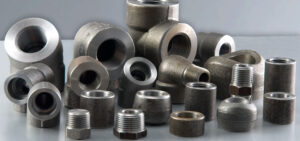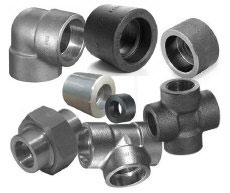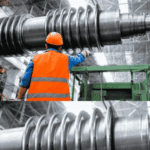Contact : +91-79045 61980 | Email: hydrofitengineers@gmail.com
Find the Hydraulic Fittings-Types and Applications for Best Practices

In this ultimate guide to hydraulic fittings, we will discuss what is hydraulic tube fittings-types and applications and how to select the right one and where they are used in different industries. We’ll also cover some important installation tips that can keep our systems going strong.
Powerful hydraulic systems are the heart of a majority of industrial and mobile machines. From portable heavy machinery to complex CNC cutting machines, such systems use fluid power for efficient movement and operation. The heart of these systems are hydraulic tubing lines & fittings which serve to transfer fluid between different components at a high pressure to ensure no leakage. When going about your business, be it with hydraulic fittings or compression ones such as the O-ring you need to make sure that there is a perfect fit so as to keep both performance and safety optimized.
What Are Hydraulic Tube Fittings?
These fittings are common connectors in hydraulic systems, directing and containing the flow of hydraulic liquid. Use these fittings in extreme-pressure conditions and for joining heavy duty hose lines, provide a secure connection that is leak free. They are essentially designed to allow the effective transfer of fluid in the hydraulic circuit, thus ensuring efficient power transmission and control.
These fittings are constructed from one of three materials stainless steel, brass or carbon steel material and that material is noted in our descriptions below. It can be purchased in a straight body, elbow, T-shape and so forth to suit more complicated system flows.
There are generally two types of fittings:
Hydraulic tube fittings: for use in rigid pipelines. We are the leading supplier of Hydraulic Tube Fittings in chennai.
Hydraulic Hose Fittings: Perfect for systems that require tubing flexibility and vibration resistance. Explore more
The fittings you choose will have to be the right type of fitting for durability, application fluid compatibility and resistance to pressure.
Types of Hydraulic Fittings
They also come in different styles and address a variety of needs. There are several main ones that people typically use :
Hydraulic Tube Fittings: These are used to join rigid metal tubes in high pressure hydraulic systems. These are normally threaded or flanged and are used for applications that need heavy sealing and sturdiness.
Hydraulic Hose Fittings: When used with even the highest pressure hoses, they will withstand required bending without leakage. Use them in areas where vibration is a concern. They are available in crimp and reusable versions and are used to join hoses to pumps, valves and cylinders.
Hydraulic Ferrule Fittings: Hydraulic ferrule fittings have a metal sleeve (ferrule) that bites into the outer surface of the hose when you crimp. This style provides a tight secure connection, especially where high pressure is being used. They’re widely employed in the oil & gas, chemical and heavy machinery sectors.
Hydraulic Tube Compression Fittings: These fittings are tightened with a wrench to compress the compression nut and ferrules onto the tubing. Hydraulic tube compression fittings offer easy assembly/repair solutions for hydraulic applications, requiring no special tools or welding.
Both fittings have their own benefits and are chosen depending on application, pressure rating and material of the fluid being passed though the hose.


Choosing the Right Hydraulic Fittings
Choosing the right fitting is an important aspect to the performance and service life of a hydraulic system. Here’s what to consider:
- Pressure Rating: Ensure the fitting is suitable for the maximum pressure of the system.
- Material Conclusion: Select the fitting material (i.e. stainless steel, brass) compatible with your fluid to avoid corrosion of the pipe thread.
- Size & Thread Type: This is very important to prevent mismatched connections.
- Type of application: Opt for either hydraulic tube fittings or hydraulic hose fitting s to match the system design.
- Working temperature: Make sure the fitting is able to handle the working temperature range of your hydraulic fluid.
An advisor’s input and reference to ISO standards (e.g., ISO 8434) is suggested when specifying fittings for critical systems.
Best Practices For Installation
Correctly fitted Hydraulic fittings eliminates leaks, damage, expensive downtime. Here are some best practices:
- Clean up all sealing surfaces from leftover debris or metal particles.
- Don’t overtighten- use the manufacturer’s prescribed torque.
- Apply thread sealants if necessary, but make sure they are compatible with hydraulic fluid.
- Hoses and tubes should be examined for wear or deformation prior to fitting installation.
- Alignment Confirmation- out of alignment parts can lead to premature wear.
By following these steps, you’ll minimize the possibility of leaks and have a hydraulic system that holds strong under pressure.
Applications Across Industries
These fittings are common in multiple industries because of their ease of use and high pressure tolerances. There are a few popular uses:

Agriculture Industry
Agricultural Hydraulic hose Fittings and Ferrule fittings are used in tractors, harvesters and irrigation systems.

Manufacturing Industry
A combination of these fittings and hose assembles operate mechanical equipment, presses and CNC machines.

Automotive Industry
For safety and performance, brake systems, power steering and suspension systems are two of the most critical mechanisms to maintain.

Oil & Gas Industry
Hydraulic ferrule fittings are commonly employed in drilling systems and rig platforms because of its high-performance feature under pressure.

Construction Industry
Tubing Fittings for Hydraulic Arms and Attachments for Bulldozers, Excavators & Backhoes.
No matter what the type of hydraulic fitting is used, mobile or stationary, goal remains the same to achieve efficient service and extend fitting life by eliminating system downtime.
Where to Buy Quality Hydraulic Fittings
When shopping for quality fittings, it is important to select a supplier that provides certified, durable and application-specific products. At Hydrofit Engineers, we cater a range of hydraulic tube fittings, hydraulic hose fittings, ferrule and compression fittings. Check more product range of Hydrofit Engineers product range for your hydraulic system
Our fittings are engineered to international tolerances and perform flawlessly in harsh industrial applications.
In the world of hydraulic systems, fittings aren’t just savers, they have a big say in the study as well: integrity, performance and safety of your system. From hydraulic tube fittings down to 3/16″ in mobile equipment, we”ve got your application covered If the fitting doesn”t match the port, one series can mar or damage both parts.
Tube Compression Fittings As hydraulic ferrule fittings, tube compression fittings, and more become a part of your repertoire, there are different types to understand so you can make informed selections no matter the application. Whether you are operating a fleet of machines, designing new equipment or you simply have very demanding applications, twisted fittings have proven to be reliable and long lasting
